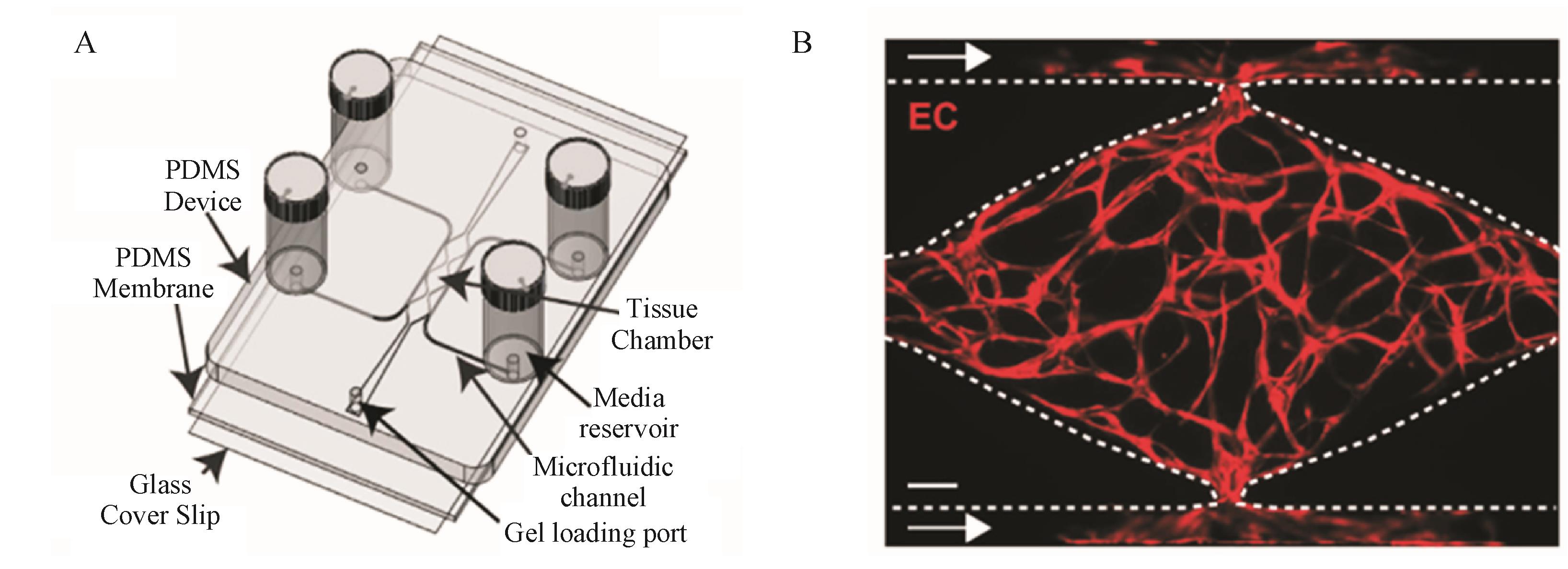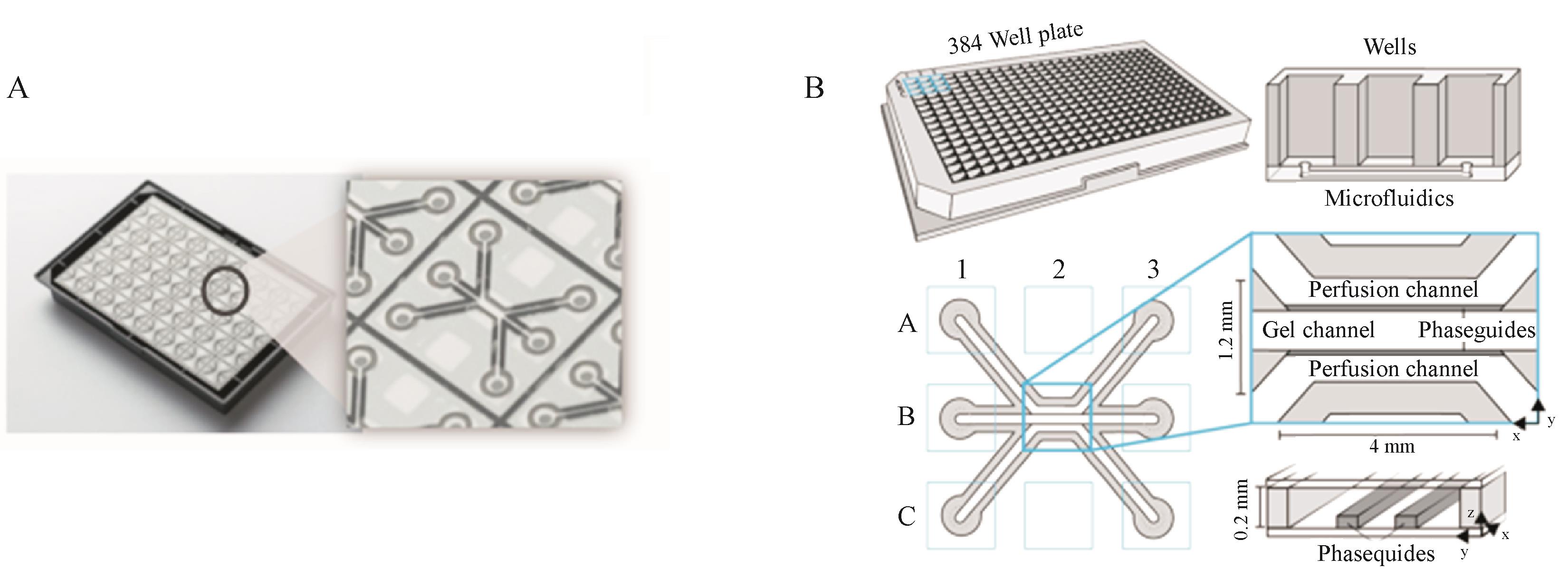摘要
随着仿生化技术的发展,越来越多的体外模型被应用于模拟人体生理和病理过程。这些体外模型可以解决一些科学问题,例如,实时地、可视化地研究药物作用等。器官芯片作为一种体外模型,为基础科学和应用科学提供了新型的手段和方法。而血管化器官芯片作为一种特殊的器官芯片,能更好地模拟人体血管的结构和功能。本文概括了不同血管化器官芯片的结构和功能,分析了血管化器官芯片在模拟生理和病理过程中的应用,讨论了血管化器官芯片作为一种新型体外模型的优势与待解决的问题。最后,对血管化器官芯片的应用前景提出了设想与展望。
关键词
康纳尔大学Shuler
本文将讨论不同血管化器官芯片在基础研究和应用研究中的价值,描述血管化器官芯片在模拟生理和病理过程中的应用,对血管化器官芯片作为一种新型体外模型的优势与待解决的问题进行了概述。
器官芯片是一种微流控设备,依托于微流体技术,在特定材料(如PDMS)组成的模具上培养多种细胞,以模拟组织和器官的生理和病理过
常规的2D细胞培养已经有50多年的历
血管化的器官芯片,即整合了血管结构和机械线索的器官芯片,近些年在药物临床前研究方面有比较优越的表现。特别是对于纳米药物分布和疗效的体外评价方面,提供了有前景的评估手段。
血管新生有两种方式,即血管再生(angiogenesis)和血管发生(vasculogenesis
自器官芯片领域的先驱Donald E. Ingber提出“器官芯片”这一新型的研究方向以来,已经有多种在体外模拟对应人体器官的器官芯
为了模拟血管形成过程,Kim

Figure 1 Microfluidic chip for in vitro angiogenesis regulatio
另外,创建血管发生的微流体模型同样也引起了极大的兴趣,研究人员设计了一种含有多重腔室的微流体模

Figure 2 Microfluidic chip for in vitro vasculogenesis regulation
A: Schematic of the microfluidic platform; B: Representative tissue chamber with vascular network on day 7 (ECFC-EC, red). Scale bar=100 μm PDMS: Polydimethyl siloxane
为了在体外实现平行多组实验、获得更多样本量的目的,van Duinen

Figure 3 High-throughput microfluidic chip for angiogenic sprouting regulatio
A: Bottom of the microfluidic chip based on a 384-well plate including 40 microfluidic devices; B: Every device consists of three channels. Phaseguides prevent the patterned gel from flowing into the adjacent channels
生理芯片主要是涉及到人体正常细胞的培养或组织界面生成等,而病理芯片通常是在生理芯片的基础上掺入病理因素,如肿瘤细胞或疾病相关因子
Wang

Figure 4 Microfluidic chip for forming the tumor-vasculatur
A: In vivo tumor microenvironment consists of leaky vasculature and tumor tissues; B: Constituent elements of the in vitro tumor-vasculature-on-a-chip(TVOC) model
为了克服这些不足,Paek

Figure 5 Microfluidic chip for generating vascularized tumor construct
A: Schematic of mimic malignant solid tumors in the lung; B: Cancer spheroids composed of A549 cells (green) and RFP-HUVECs (red) grow in size during culture and integrate with the surrounding vasculature. Scale bar=50 μm
同样的,Nashimoto
另外,为了在体外肿瘤芯片上获得更多的生物信息,越来越多的研究使用微流控芯片联合检测系统,基于此更好地捕捉病理状态下复杂的变化。Carvalho

Figure 6 Microfluidic chip established for simulating microvascular 3D microenvironment of colorectal tumor
HCT-116 (CRC cells, red) , HCoMEC (yellow)
综上所述,血管化器官芯片可以很好地模拟出不同状态下的生理和病理过程,通过灌注给药可模拟药物在体内循环过程以及在特定部位的蓄积。特别是血管化肿瘤芯片可以为开发新的肿瘤疗法(尤其是纳米药物)提供一种新型手段,在体外通过集成检测系统(如实时成像系统等),可以更好地细化相应疗法的作用范围和作用机制,给探索疗法的器官特异性和肿瘤异质性响应提供了可能性。
血管化器官芯片作为一种新型体外模型,具有诸多优势,表现在4个方面:其一,集成了灌注系统(连续灌注、双向灌注等)的血管化器官芯片优于普通的静态模型,血管系统中流体流动形成的剪切力、物理和化学梯度等,可以更加贴近体内的动态环境。其二,通过复制不同的体内过程,可在体外控制单因素变量,便于人们更好地理解生长发育过程以及疾病发生发展。其三,相比于不同肿瘤都使用相同的模型(如2D细胞、动物皮下肿瘤模型)去检测药物活性,血管化器官芯片提供了个性化的检测手段。并且可以共培养器官特异性的相关细胞,可在一定程度上解决动物模型和人类之间存在的异源性问题。其四,因为微流控芯片的可视性和易取样的特点,便于收集在不同时间和空间的不同样品,有利于进行后续的分子、细胞、标志物、基因等的分析。
血管化器官芯片目前也存在着一些尚待解决的问题,表现在4个方面:其一,构建血管化器官芯片的关键在于准确模拟出体内复杂的生理或病理学环境,所以在体外模型构建完成之后,还需要验证模型的有效性和可靠性,这种验证还需要指定一系列的标准,目前缺乏这样的标准。其二,血管化器官芯片上体外模型的构建,比起普通常用的体外模型,操作更难也更不好普及,特别是比较难以实现高通量的筛选。因此,如何保证可重复性高,是一个巨大的挑战。其三,现行微流控芯片趋向于往更复杂的方向上发展,集成诸多因素(多种细胞、多种培养模式、不同细胞因子、流体系统等),如何控制多种因素之间的相互作用才能实现最佳的性质和功能,这也是一个挑战。目前构建的血管化器官芯片,还缺乏一些人们更加关注的因素,比如免疫细胞(如,巨噬细胞)。其四,制造器官芯片常用的材料PDMS,被证明对小分子存在非特异性吸
血管化器官芯片自出现以来,发展出许多具有复杂结构的模型。这些芯片可模拟同种生理或病理过程,或是一种结构的芯片加以微小的改造可用来模拟多种生理或病理过程,都旨在模拟出体内最真实的环境。本课题组致力于开发微流控芯片上的血管化肿瘤球模型,用于评估纳米颗粒在肿瘤处的分布和疗效。在构建准确度高、重现性高的体外模型的基础上,将模型应用于纳米颗粒在实验室阶段的筛选过程,从而增加纳米颗粒体外评价方法的多样性和准确性。
血管化器官芯片在药物发现和开发领域存在着巨大潜力,相比于目前的动物模型,可以更准确地预测临床试验结果。在临床前药物开发阶段,可以使用芯片对于药物的作用机制、可能存在的毒性等进行深入探究,并且可以与体内结果形成对比,用以综合评估药物。血管化器官芯片也为个性化治疗提供了更多的可能,通过在芯片中培养正常人体或者患者来源的细胞和组织,可以进行针对特定群体或个人的特异性药物评估,这在一定程度上可以解决疾病异质性(如肿瘤异质性)问题。血管化器官芯片还可以为现阶段存在开发困难的药物提供一个新的解决途径,如孤儿药等,这些药物的开发存在疾病罕见、患者样本量少、药物研发伦理学等问题,使用芯片培养体外模型,给此类药物的开发提供了便利和更多的可能性。
血管化器官芯片集成了血管系统和机械线索等诸多因素,可以在时间和空间上都高分辨率地观察到分子、细胞、器官水平的真实响应。通过集成不同的系统,扩大和完善芯片的应用范围,具有传统体外系统无法比拟的优势。虽然目前也存在需要克服的问题,但是经过先进技术的发展和整个体系的改善,有望提高芯片上体外模型的准确性和耐用性等。目前也有许多芯片进入商业化阶
References
Esch MB,King TL,Shuler ML. The role of body-on-a-chip devices in drug and toxicity studies[J]. Annu Rev Biomed Eng,2011,13:55-72. [百度学术]
Majesky MW. Vascular development[J]. Arterioscler Thromb Vasc Biol,2018,38(3):e17-e24. [百度学术]
Poole DC,Behnke BJ,Musch TI. The role of vascular function on exercise capacity in health and disease[J]. J Physiol,2021,599(3):889-910. [百度学术]
Alves CH,Fernandes R,Santiago AR,et al. Microglia contribution to the regulation of the retinal and choroidal vasculature in age-related macular degeneration[J]. Cells,2020,9(5):1217. [百度学术]
Souilhol C,Harmsen MC,Evans PC,et al. Endothelial-mesenchymal transition in atherosclerosis[J]. Cardiovasc Res,2018,114(4):565-577. [百度学术]
Filipowska J,Tomaszewski KA,Niedźwiedzki Ł,et al. The role of vasculature in bone development,regeneration and proper systemic functioning[J]. Angiogenesis,2017,20(3):291-302. [百度学术]
Shemmeri E,Vallières E. Blunt tracheobronchial trauma[J]. Thorac Surg Clin,2018,28(3):429-434. [百度学术]
Li XR,Sun XD,Carmeliet P. Hallmarks of endothelial cell metabolism in health and disease[J]. Cell Metab,2019,30(3):414-433. [百度学术]
Bhatia SN,Ingber DE. Microfluidic organs-on-chips[J]. Nat Biotechnol,2014,32(8):760-772. [百度学术]
Sontheimer-Phelps A,Hassell BA,Ingber DE. Modelling cancer in microfluidic human organs-on-chips[J]. Nat Rev Cancer,2019,19(2):65-81. [百度学术]
Kieninger J,Weltin A,Flamm H,et al. Microsensor systems for cell metabolism - from 2D culture to organ-on-chip[J]. Lab Chip,2018,18(9):1274-1291. [百度学术]
Gęgotek A,Atalay S,Domingues P,et al. The differences in the proteome profile of cannabidiol-treated skin fibroblasts following UVA or UVB irradiation in 2D and 3D cell cultures[J]. Cells,2019,8(9):995. [百度学术]
Nugraha B,Buono MF,von Boehmer L,et al. Human cardiac organoids for disease modeling[J]. Clin Pharmacol Ther,2019,105(1):79-85. [百度学术]
van Zundert I,Fortuni B,Rocha S. From 2D to 3D cancer cell models-the enigmas of drug delivery research[J]. Nanomaterials (Basel),2020,10(11):2236. [百度学术]
Drost J,Clevers H. Organoids in cancer research[J]. Nat Rev Cancer,2018,18(7):407-418. [百度学术]
Zanoni M,Cortesi M,Zamagni A,et al. Modeling neoplastic disease with spheroids and organoids[J]. J Hematol Oncol,2020,13(1):97. [百度学术]
Robinson NB,Krieger K,Khan FM,et al. The Current state of animal models in research:a review[J]. Int J Surg,2019,72:9-13. [百度学术]
Potente M,Carmeliet P. The link between angiogenesis and endothelial metabolism[J]. Annu Rev Physiol,2017,79:43-66. [百度学术]
Brassard-Jollive N,Monnot C,Muller L,et al. In vitro 3D systems to model tumor angiogenesis and interactions with stromal cells[J]. Front Cell Dev Biol,2020,8:594903. [百度学术]
Naito H,Iba T,Takakura N. Mechanisms of new blood-vessel formation and proliferative heterogeneity of endothelial cells[J]. Int Immunol,2020,32(5):295-305. [百度学术]
Azevedo Portilho N,Pelajo-Machado M. Mechanism of hematopoiesis and vasculogenesis in mouse placenta[J]. Placenta,2018,69:140-145. [百度学术]
Glembotski CC,Rosarda JD,Wiseman RL. Proteostasis and beyond:ATF6 in ischemic disease[J]. Trends Mol Med,2019,25(6):538-550. [百度学术]
Campbell K. Contribution of epithelial-mesenchymal transitions to organogenesis and cancer metastasis[J]. Curr Opin Cell Biol,2018,55:30-35. [百度学术]
Veith AP,Henderson K,Spencer A,et al. Therapeutic strategies for enhancing angiogenesis in wound healing[J]. Adv Drug Deliv Rev,2019,146:97-125. [百度学术]
Hamidi H,Ivaska J. Every step of the way:integrins in cancer progression and metastasis[J]. Nat Rev Cancer,2018,18(9):533-548. [百度学术]
Faubert B,Solmonson A,DeBerardinis RJ. Metabolic reprogramming and cancer progression[J]. Science,2020,368(6487):eaaw5473. [百度学术]
Huh D,Matthews BD,Mammoto A,et al. Reconstituting organ-level lung functions on a chip[J]. Science,2010,328(5986):1662-1668. [百度学术]
Zhu YJ,Sun LY,Wang Y,et al. A biomimetic human lung-on-a-chip with colorful display of microphysiological breath[J]. Adv Mater,2022,34(13):e2108972. [百度学术]
Huang D,Liu TT,Liao JL,et al. Reversed-engineered human alveolar lung-on-a-chip model[J]. Proc Natl Acad Sci U S A,2021,118(19):e2016146118. [百度学术]
Novak R,Ingram M,Marquez S,et al. Robotic fluidic coupling and interrogation of multiple vascularized organ chips[J]. Nat Biomed Eng,2020,4(4):407-420. [百度学术]
Huang DQ,Zhang XX,Fu X,et al. Liver spheroids on chips as emerging platforms for drug screening[J]. Eng Regen,2021,2:246-256. [百度学术]
Young RE,Huh DD. Organ-on-a-chip technology for the study of the female reproductive system[J]. Adv Drug Deliv Rev,2021,173:461-478. [百度学术]
Herland A,Maoz BM,Das D,et al. Quantitative prediction of human pharmacokinetic responses to drugs via fluidically coupled vascularized organ chips[J]. Nat Biomed Eng,2020,4(4):421-436. [百度学术]
Kim S,Lee H,Chung M,et al. Engineering of functional,perfusable 3D microvascular networks on a chip[J]. Lab Chip,2013,13(8):1489-1500. [百度学术]
Lee S,Kim S,Koo DJ,et al. 3D microfluidic platform and tumor vascular mapping for evaluating anti-angiogenic RNAi-based nanomedicine[J]. ACS Nano,2021,15(1):338-350. [百度学术]
Lee S,Chung M,Lee SR,et al. 3D brain angiogenesis model to reconstitute functional human blood-brain barrier in vitro[J]. Biotechnol Bioeng,2020,117(3):748-762. [百度学术]
Park YC,Zhang CT,Kim S,et al. Microvessels-on-a-chip to assess targeted ultrasound-assisted drug delivery[J]. ACS Appl Mater Interfaces,2016,8(46):31541-31549. [百度学术]
Chung M,Ahn J,Son K,et al. Biomimetic model of tumor microenvironment on microfluidic platform[J]. Adv Healthc Mater,2017,6(15). doi:10.1002/adhm.201700196. [百度学术]
Oh S,Ryu H,Tahk D,et al. “Open-top” microfluidic device for in vitro three-dimensional capillary beds[J]. Lab Chip,2017,17(20):3405-3414. [百度学术]
Ahn J,Cho CS,Cho SW,et al. Investigation on vascular cytotoxicity and extravascular transport of cationic polymer nanoparticles using perfusable 3D microvessel model[J]. Acta Biomater,2018,76:154-163. [百度学术]
Wang XL,Phan DTT,Sobrino A,et al. Engineering anastomosis between living capillary networks and endothelial cell-lined microfluidic channels[J]. Lab Chip,2016,16(2):282-290. [百度学术]
Sobrino A,Phan DTT,Datta R,et al. 3D microtumors in vitro supported by perfused vascular networks[J]. Sci Rep,2016,6:31589. [百度学术]
van Duinen V,Zhu D,Ramakers C,et al. Perfused 3D angiogenic sprouting in a high-throughput in vitro platform[J]. Angiogenesis,2019,22(1):157-165. [百度学术]
van Duinen V,Stam W,Borgdorff V,et al. Standardized and scalable assay to study perfused 3D angiogenic sprouting of iPSC-derived endothelial cells in vitro[J]. J Vis Exp,2019(153). doi:10.3791/59678. [百度学术]
van Duinen V,van den Heuvel A,Trietsch SJ,et al. 96 perfusable blood vessels to study vascular permeability in vitro[J]. Sci Rep,2017,7(1):18071. [百度学术]
Poussin C,Kramer B,Lanz HL,et al. 3D human microvessel-on-a-chip model for studying monocyte-to-endothelium adhesion under flow - application in systems toxicology[J]. ALTEX,2020,37(1):47-63. [百度学术]
Zhu LY,Shao CM,Chen HX,et al. Hierarchical hydrogels with ordered micro-nano structures for cancer-on-a-chip construction[J]. Research (Wash D C),2021,2021:9845679. [百度学术]
Wang HF,Ran R,Liu Y,et al. Tumor-vasculature-on-a-chip for investigating nanoparticle extravasation and tumor accumulation[J]. ACS Nano,2018,12(11):11600-11609. [百度学术]
Paek J,Park SE,Lu QZ,et al. Microphysiological engineering of self-assembled and perfusable microvascular beds for the production of vascularized three-dimensional human microtissues[J]. ACS Nano,2019,13(7):7627-7643. [百度学术]
Nashimoto Y,Okada R,Hanada S,et al. Vascularized cancer on a chip:the effect of perfusion on growth and drug delivery of tumor spheroid[J]. Biomaterials,2020,229:119547. [百度学术]
Nashimoto Y,Hayashi T,Kunita I,et al. Integrating perfusable vascular networks with a three-dimensional tissue in a microfluidic device[J]. Integr Biol (Camb),2017,9(6):506-518. [百度学术]
Nashimoto Y,Teraoka Y,Banan Sadeghian R,et al. Perfusable vascular network with a tissue model in a microfluidic device[J]. J Vis Exp,2018(134):57242. [百度学术]
Carvalho MR,Barata D,Teixeira LM,et al. Colorectal tumor-on-a-chip system:a 3D tool for precision onco-nanomedicine[J]. Sci Adv,2019,5(5):eaaw1317. [百度学术]
Zhang BY,Radisic M. Organ-on-a-chip devices advance to market[J]. Lab Chip,2017,17(14):2395-2420. [百度学术]